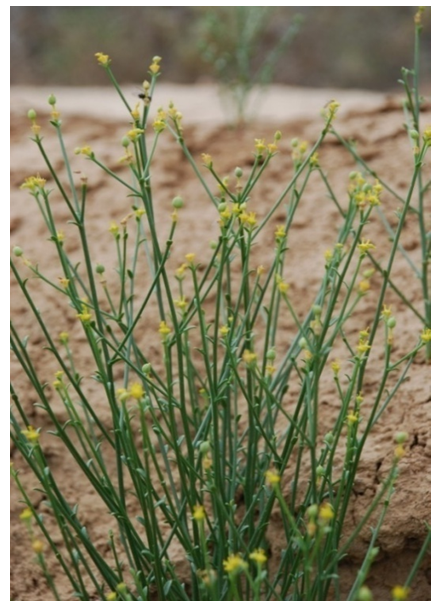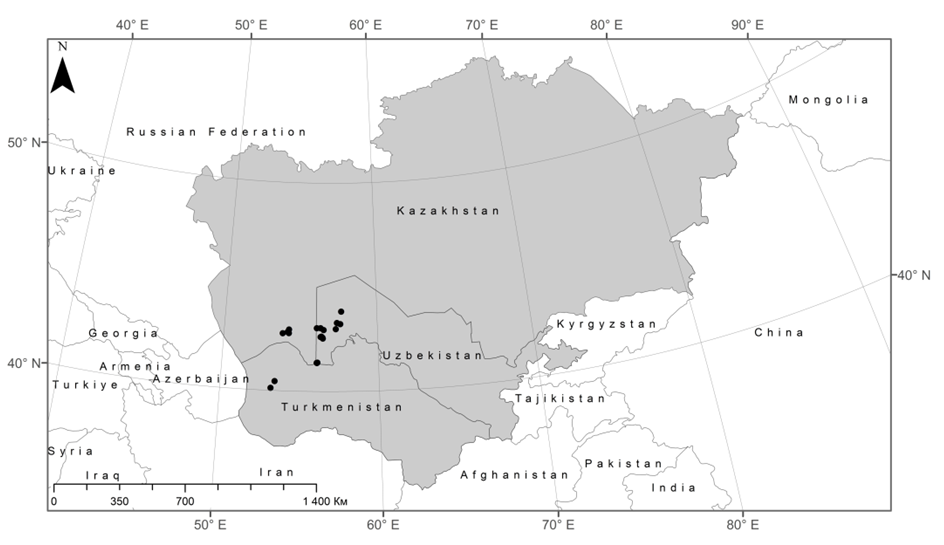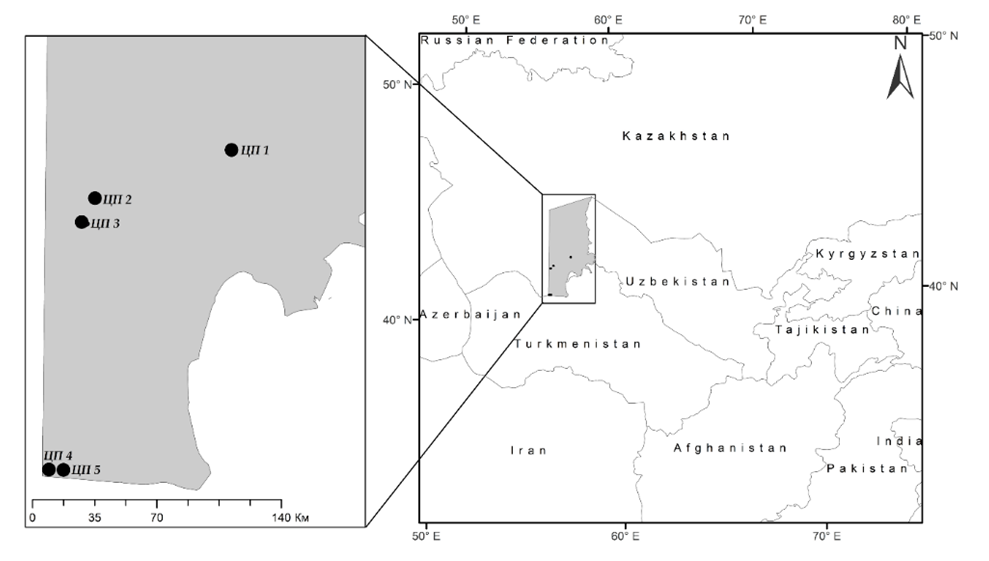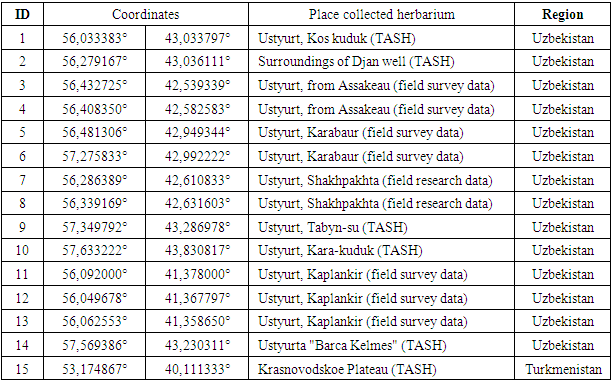-
Paper Information
- Paper Submission
-
Journal Information
- About This Journal
- Editorial Board
- Current Issue
- Archive
- Author Guidelines
- Contact Us
International Journal of Virology and Molecular Biology
p-ISSN: 2163-2219 e-ISSN: 2163-2227
2023; 12(3): 40-44
doi:10.5923/j.ijvmb.20231203.02
Received: Sep. 20, 2023; Accepted: Oct. 5, 2023; Published: Oct. 8, 2023

Localities of Euphorbia Sclerocyanthium Cenopopulations on the Territory of Karakalpak Ustyurt
Shakhigul Tamambetova
Senior Lecturer of Botany, Ecology and Methods of Teaching Chair, Nukus State Pedagogical Institute, Nukus, Uzbekistan
Correspondence to: Shakhigul Tamambetova, Senior Lecturer of Botany, Ecology and Methods of Teaching Chair, Nukus State Pedagogical Institute, Nukus, Uzbekistan.
Copyright © 2023 The Author(s). Published by Scientific & Academic Publishing.
This work is licensed under the Creative Commons Attribution International License (CC BY).
http://creativecommons.org/licenses/by/4.0/

The article discusses the brief ecologo-phytocenotic nature of the scattered Euphorbia sclerocyathium in the Karakalpakstan part of the Ustyurt of the 5 tsenopopulia. The extent of covering the soil surface of the community, Floristic composition, scattered area of the tsenopopulia, geographical points and cordinata have been cited. Negative effects of anthropogenic and other environmental factors have been shown. Euphorbia sclerocyanthium is a rare and species in demand for conservation. This species is endemic to the southern Ustyurt plateau.
Keywords: Euphorbia sclerocyathium, Ustyurt plateau, Tsenopopulia, Community, Phytocenosis, Relief, Geographical point, Red Book, Environmental factors
Cite this paper: Shakhigul Tamambetova, Localities of Euphorbia Sclerocyanthium Cenopopulations on the Territory of Karakalpak Ustyurt, International Journal of Virology and Molecular Biology, Vol. 12 No. 3, 2023, pp. 40-44. doi: 10.5923/j.ijvmb.20231203.02.
1. Introduction
- The urgency of studying rare and endangered plant species is determined by the importance of the tasks of their preservation as elements of biodiversity. This problem may be solved on the basis of a comprehensive study of rare and endangered plant species, their bioecological features, and survival strategy. Such studies are necessary for protecting rare and economically valuable plant species, as well as for the rational use of natural communities and creation of artificial plant communities (Baktasheva and Indzheeva, 2014). The coenopopulation approach is the optimal method for assessing the current status of populations of rare and endangered species. Such studies are widely used in Russia, Belarus, Ukraine, the Baltic states, and in Central Asia. Systematic research to assess the status of populations of rare and endangered species using coenopopulation approaches was started in Uzbekistan not long ago. Since 2012, employees of the Laboratory of Geobotany of the Institute of Botany of the Academy of Sciences of the Republic of Uzbekistan have performed studies to identify rare plant communities in the plant cover of Uzbekistan (including the Ustyurt Plateau) that need protection to assess their current status, and to develop protection measures. The territory of the study. The Ustyurt Plateau is represented by dry clay desert located in the area of three Central Asian states: Uzbekistan, Kazakhstan, and Turkmenistan. The plateau is bordered on almost all sides by cliffs. Ustyurt is surrounded by the Caspian Lowland from the north, by the drained bottom of the Aral Sea from the east, by the Amu Darya delta and the Sarykamysh depression from the south, and by the Caspian Sea from the west. The total area of Ustyurt is 21.2 million ha, and the Karakalpak part comprises 7.2 million ha. The flora of the Ustyurt Plateau includes 724 species assigned to 295 genera and 60 families (Sarybaev, 1994). The plant cover includes a few species, forming monodominant communities: Salsola arbusculiformis, Anabasis salsa, Artemisia terrae-alba, Haloxylon aphyllum, and Salsola orientalis. Less often, the dominants and subdominants of plant communities are represented by Salsola arbuscula, Atraphaxis spinosa, Stipa richteriana, S. hohenackeriana, S. gemmascens, and Nanophyton erinaceum. Endemics of the Ustyurt and of the drained bottom of the Aral Sea include species of gypsum deserts: Salsola chiwensis and Sisymbrium subspinenscens, as well as Crataegus korolkowii, Artemisia austriaca, Atriplex pratovii, and Crambe edentula. Among species listed in the Red Data Book of Uzbekistan (2019) are Malococarpus crithmifolius, Climacoptera ptiloptera, Euphorbia sclerocyathium, and Xylosalsola chiwensis. The species composition of the Karakalpak Ustyurt has not yet been completely studied. [7, p. 189–195; 6, p.377-382]. Euphorbia sclerocyanthium is one of the few rare endemics of the insular and Caspian regions that have the potential for active vegetative propagation.The species is extremely interesting, both in terms of its morphology. as well as in its rheographic distribution. Ero family ties to other genera have not yet been established. The authors of the species note in their dianosis ero a separate position. It is possible that the genus fragment of African vegetation he represents. The range of this plant is also extremely curious. Outside the noted localities, which stretch in a narrow strip between the eastern coast of the Caspian Sea and the outskirts of the Ust-Urt Upland, this species has not been observed anywhere else [5, p. 336].Euphorbia sclerocyanthium is distributed in Uzbekistan (Karakalpakstan, Ustyurt), Kazakhstan (Mangishlok), Turkmenistan (Karakum, Krasnovodsk).The species grows in places that differ in the forms of relief, the mechanical composition of the soil [2, p. 82-84]. However, territories with surface location of saline soils and parent rock are considered suitable for this species. In the island region, the species is widely distributed in stony and sandy deserts, on saline gray-brown and gypsum soils [12, p. 27-32].
 | Figure 1. Distribution areas of Euphorbia sclerocyathium |
2. Objects and Methods
- The objects of study were: Euphorbia sclerocyathium Korovin & Popov.
 | Figure 2. Euphorbia sclerocyathium (Karabovur point, Central Karakalpak Ustyurti) |
 | Figure 3. Areas where Euphorbia sclerocyathium is distributed |
|
3. Results and Discussion
- It was found that all cenopopulations of Euphorbia sclerocyathium are located in the central and southern parts of Karakalpak Ustyurt (Fig. 4).
 | Figure 4. Location of cenopopulations of Euphorbia sclerocyathium |
|
4. Conclusions
- Over the past 10 years, the development of the oil and gas industry in the Aral Sea region, the construction of roads, the transfer of gas pipelines have had a negative impact on the vegetation cover. The development of heavy vehicles, the destruction of the fertile soil layer, and the mining activities in the regions have led to a reduction in the habitat of rare plant species. E.sclerocyathium is listed in the Red Data Book of the Republic of Kazakhstan (2014) with status 2. The species was included with status 2 in the 2009 edition of the Red Data Book of the Republic of Uzbekistan, while in the latest edition (2019) its status was upgraded (1) [10, p 127; 8, p. 256; 9, p. 174].Most interesting is the fact that the island zone endem Euphorbia sclerocyanthium is also distributed in these developed areas, the width of the distribution area, lability to soil conditions, biological features mark a critical consideration of the state of the species from the point of view of conservation.
 Abstract
Abstract Reference
Reference Full-Text PDF
Full-Text PDF Full-text HTML
Full-text HTML
